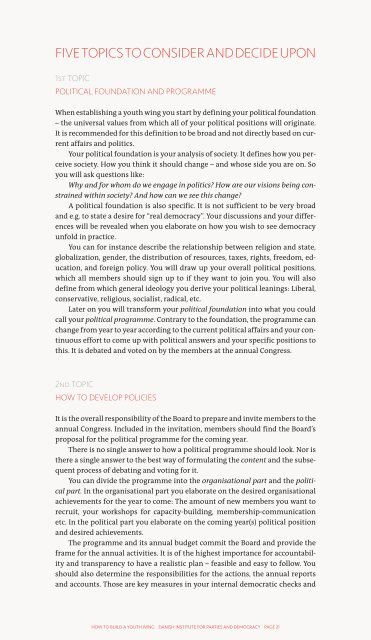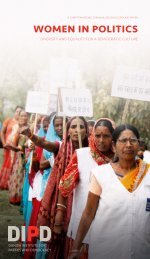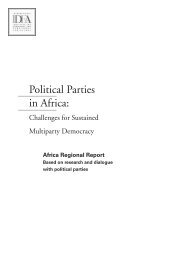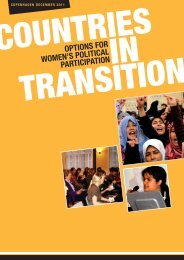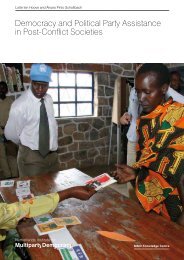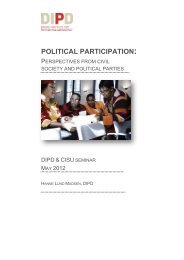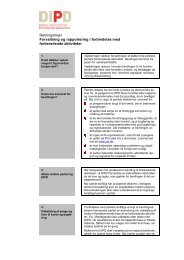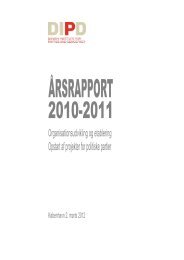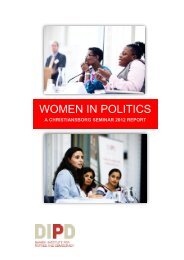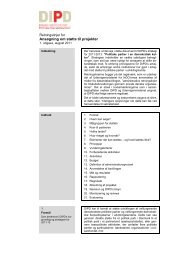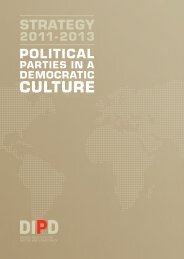HOW TO BUILD A YOUTH WING
HOW TO BUILD A YOUTH WING
HOW TO BUILD A YOUTH WING
Create successful ePaper yourself
Turn your PDF publications into a flip-book with our unique Google optimized e-Paper software.
FIVE <strong>TO</strong>PICS <strong>TO</strong> CONSIDER AND DECIDE UPON<br />
1st <strong>TO</strong>PIC<br />
POLITICAL FOUNDATION AND PROGRAMME<br />
When establishing a youth wing you start by defining your political foundation<br />
– the universal values from which all of your political positions will originate.<br />
It is recommended for this definition to be broad and not directly based on current<br />
affairs and politics.<br />
Your political foundation is your analysis of society. It defines how you perceive<br />
society. How you think it should change – and whose side you are on. So<br />
you will ask questions like:<br />
Why and for whom do we engage in politics? How are our visions being constrained<br />
within society? And how can we see this change?<br />
A political foundation is also specific. It is not sufficient to be very broad<br />
and e.g. to state a desire for “real democracy”. Your discussions and your differences<br />
will be revealed when you elaborate on how you wish to see democracy<br />
unfold in practice.<br />
You can for instance describe the relationship between religion and state,<br />
globalization, gender, the distribution of resources, taxes, rights, freedom, education,<br />
and foreign policy. You will draw up your overall political positions,<br />
which all members should sign up to if they want to join you. You will also<br />
define from which general ideology you derive your political leanings: Liberal,<br />
conservative, religious, socialist, radical, etc.<br />
Later on you will transform your political foundation into what you could<br />
call your political programme. Contrary to the foundation, the programme can<br />
change from year to year according to the current political affairs and your continuous<br />
effort to come up with political answers and your specific positions to<br />
this. It is debated and voted on by the members at the annual Congress.<br />
2nd <strong>TO</strong>PIC<br />
<strong>HOW</strong> <strong>TO</strong> DEVELOP POLICIES<br />
It is the overall responsibility of the Board to prepare and invite members to the<br />
annual Congress. Included in the invitation, members should find the Board’s<br />
proposal for the political programme for the coming year.<br />
There is no single answer to how a political programme should look. Nor is<br />
there a single answer to the best way of formulating the content and the subsequent<br />
process of debating and voting for it.<br />
You can divide the programme into the organisational part and the political<br />
part. In the organisational part you elaborate on the desired organisational<br />
achievements for the year to come: The amount of new members you want to<br />
recruit, your workshops for capacity-building, membership-communication<br />
etc. In the political part you elaborate on the coming year(s) political position<br />
and desired achievements.<br />
The programme and its annual budget commit the Board and provide the<br />
frame for the annual activities. It is of the highest importance for accountability<br />
and transparency to have a realistic plan – feasible and easy to follow. You<br />
should also determine the responsibilities for the actions, the annual reports<br />
and accounts. Those are key measures in your internal democratic checks and<br />
<strong>HOW</strong> <strong>TO</strong> <strong>BUILD</strong> A <strong>YOUTH</strong> <strong>WING</strong> DANIsH INsTITUTe fOr pArTIes AND DemOcrAcY pAGe 21


